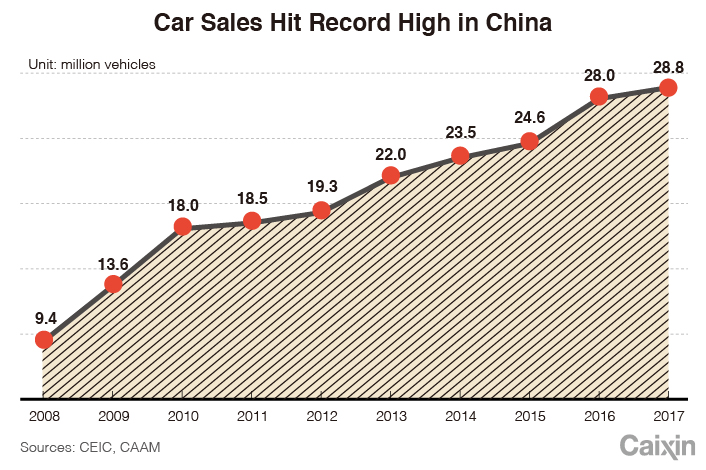The Growing Influence Of Chinese Auto Manufacturers On The Global Stage

Table of Contents
China's automotive industry is exploding onto the global scene. In just a few decades, it has transitioned from producing primarily low-cost vehicles to becoming a major player, challenging established automakers with innovative technologies and aggressive expansion strategies. The growing influence of Chinese auto manufacturers on the global stage is undeniable. Once primarily known for producing low-cost vehicles, Chinese brands are rapidly transforming the automotive landscape through innovation, aggressive expansion, and strategic partnerships. This article will explore the key factors driving this rise, including technological advancements, market penetration strategies, global collaborations, and the challenges these manufacturers face.
H2: Technological Advancements Driving the Rise of Chinese Automakers:
The rapid growth of Chinese automakers isn't just about quantity; it's fueled by significant technological leaps. They're not merely catching up; in several areas, they're leading the way.
H3: Electric Vehicle (EV) Dominance:
China is a global powerhouse in EV battery technology, production, and charging infrastructure. Government support, massive investments, and a focus on innovation have propelled Chinese EV brands to the forefront.
- Examples of innovative EV technologies from Chinese manufacturers: BYD's Blade Battery technology offers higher energy density and improved safety. NIO's battery swap technology significantly reduces charging time. Xpeng's advanced autonomous driving features are pushing the boundaries of what's possible.
- Government support and subsidies for EV development: Generous government subsidies and tax incentives have stimulated the development and adoption of EVs in China, creating a fertile ground for innovation.
- Comparison to Western EV manufacturers: While Tesla remains a major player, Chinese manufacturers are rapidly closing the gap, offering competitive pricing and advanced features.
H3: Autonomous Driving Capabilities:
Chinese automakers are making significant strides in autonomous driving technology, investing heavily in artificial intelligence (AI) and sensor integration.
- Specific examples of autonomous driving features in Chinese vehicles: Many Chinese EVs boast advanced driver-assistance systems (ADAS), including adaptive cruise control, lane-keeping assist, and automatic emergency braking. Some are even testing fully autonomous driving capabilities in controlled environments.
- Partnerships with technology companies: Collaborations with leading AI and technology companies are accelerating the development and deployment of autonomous driving features.
- Regulations and safety standards: While regulations are still evolving, China is actively working on establishing robust safety standards for autonomous vehicles.
H3: Connectivity and Smart Features:
Chinese vehicles are increasingly equipped with sophisticated infotainment systems, seamless internet connectivity, and over-the-air (OTA) updates.
- Examples of cutting-edge smart features: Voice assistants, large touchscreens, integrated apps, and personalized driver profiles are becoming standard features in many Chinese vehicles.
- Data collection and analysis: The collection and analysis of vehicle data provide valuable insights for improving vehicle performance, safety, and user experience.
- Cybersecurity concerns: As vehicles become more connected, cybersecurity remains a critical concern that needs to be addressed.
H2: Aggressive Market Expansion Strategies:
Chinese automakers aren't just dominating the domestic market; they're aggressively expanding globally.
H3: Global Market Penetration:
Chinese manufacturers are entering new markets through a combination of direct sales, joint ventures, and acquisitions.
- Examples of Chinese brands entering specific global markets: Brands like MG (owned by SAIC) have successfully established a presence in European markets. Others are targeting markets in Southeast Asia, South America, and Africa.
- Marketing and branding strategies: Adapting marketing strategies to suit different cultural contexts is crucial for success in global markets.
- Challenges faced in different markets: Navigating differing regulatory landscapes, consumer preferences, and competition from established brands poses significant challenges.
H3: Competitive Pricing and Value Proposition:
A key factor in the success of Chinese automakers is their ability to offer competitive pricing and a strong value proposition.
- Pricing strategies compared to competitors: Chinese brands often offer more features and technology at a lower price point compared to established competitors.
- Features and specifications offered at different price points: This allows them to target a wider range of consumers with varying budgets.
- Consumer perception of value: Building consumer trust and changing perceptions about the quality and reliability of Chinese vehicles is an ongoing process.
H2: Strategic Partnerships and Global Collaborations:
Chinese automakers are leveraging strategic partnerships and collaborations to accelerate their growth.
H3: Joint Ventures and Technology Transfers:
Joint ventures with foreign automakers have facilitated technology transfer and accelerated the development of Chinese automakers.
- Examples of successful joint ventures: Numerous joint ventures between Chinese and foreign automakers have resulted in the transfer of knowledge and technology, benefiting both partners.
- Benefits and drawbacks of technology transfer: While technology transfer can significantly accelerate innovation, it also involves potential risks and challenges.
- Impact on global innovation: These partnerships have contributed to the overall advancement of automotive technology on a global scale.
H3: Acquisition of Foreign Auto Brands or Technologies:
Acquisitions have enabled Chinese companies to gain access to established brands, technologies, and distribution networks.
- Examples of acquisitions: Several Chinese automakers have acquired foreign brands or technologies to expand their capabilities and global reach.
- Reasons for acquisitions: Acquisitions provide access to established brands, technologies, and global distribution networks, accelerating market entry and expansion.
- Impact on the global automotive industry: These acquisitions are reshaping the competitive landscape of the global automotive industry.
H2: Challenges Facing Chinese Auto Manufacturers:
Despite their rapid growth, Chinese automakers still face significant challenges.
H3: Brand Perception and Trust:
Overcoming negative perceptions associated with "Made in China" products and building strong global brands remains a key challenge.
- Strategies to improve brand image: Investing in marketing and branding campaigns, emphasizing quality and innovation, and building strong customer relationships are critical.
- Marketing campaigns targeting global consumers: Tailoring marketing messages to resonate with specific cultural contexts and consumer preferences is crucial.
- Addressing concerns about quality and safety: Consistently meeting high quality and safety standards is essential for building consumer trust.
H3: Geopolitical and Trade Tensions:
Geopolitical tensions and trade wars can significantly impact the global expansion plans of Chinese automakers.
- Impact of tariffs and trade restrictions: Tariffs and trade restrictions can increase the cost of exporting vehicles and components, hindering market penetration.
- Strategies to mitigate geopolitical risks: Diversifying supply chains, establishing local manufacturing facilities, and adapting to changing geopolitical landscapes are vital.
- Diversification of supply chains: Reducing reliance on single suppliers and diversifying sourcing locations can help mitigate risks.
3. Conclusion:
The growing influence of Chinese auto manufacturers on the global stage is undeniable. Their success is driven by remarkable technological advancements in EVs, autonomous driving, and smart features, coupled with aggressive market expansion strategies and strategic global partnerships. While challenges remain in brand perception and geopolitical factors, the future prospects for Chinese automakers look bright. They are poised to continue disrupting the automotive industry with their innovative technologies and competitive offerings. Stay informed about the evolving landscape of the global automotive industry and the continued rise of Chinese auto manufacturers. Follow [your website/publication] for the latest updates and analysis on this dynamic sector.

Featured Posts
-
 Will George Santos Go To Prison His Pre Sentencing Outburst Explained
Apr 26, 2025
Will George Santos Go To Prison His Pre Sentencing Outburst Explained
Apr 26, 2025 -
 The Hunt For Lady Olive And The German Submarine A True Story
Apr 26, 2025
The Hunt For Lady Olive And The German Submarine A True Story
Apr 26, 2025 -
 Mission Impossible 7 Svalbard Filming Locations And Bts Footage
Apr 26, 2025
Mission Impossible 7 Svalbard Filming Locations And Bts Footage
Apr 26, 2025 -
 Geopolitical Showdown A Us Military Base And The China Challenge
Apr 26, 2025
Geopolitical Showdown A Us Military Base And The China Challenge
Apr 26, 2025 -
 Carolien Gehrels Appointed Chair Of Ajax Supervisory Board A Historic First
Apr 26, 2025
Carolien Gehrels Appointed Chair Of Ajax Supervisory Board A Historic First
Apr 26, 2025
